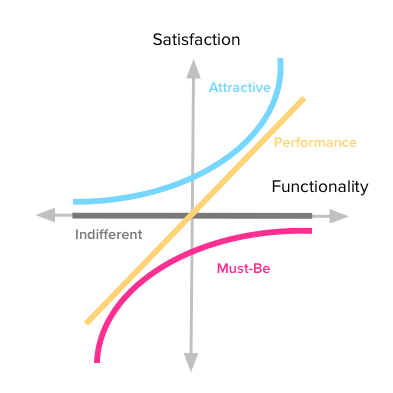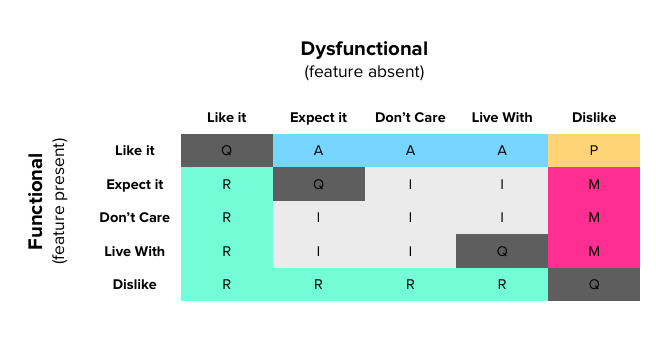What
The Kano Model helps test, categorise and prioritise potential features for new Products and Services. It classifies them into five categories by mapping them according to the Customer Satisfaction they generate on the one hand side, and the functionality they provide and the associated cost on the other. It can be used to conceptualise feature profiles, empirically research customer preferences, and inform product Strategy.
Why
- Classify product features according to their perceived value
- Create a shared understanding of a product’s value profile
- Generate guidelines for future feature development
How
- Number of participants: alone or in a small group
- Time needed: a few hours to multiple weeks, depending on the thoroughness of the empirical investigation
Description
The Kano Model maps potential features along two axes: customer satisfaction (from “frustrated” to “delighted”) and provided functionality (from “none” to “best”). Different types of features can then be mapped in the following way:

- Attractive (“delighters”): unexpected features which, when presented, cause a positive reaction.
- Performance: the more of these features you provide, the more satisfied your customers become.
- Basic (“must-have”): expected by customers; if your product doesn’t have them, it will be considered incomplete or just plain bad.
- Indifferent: features whose presence (or absence) doesn’t make a real difference in customers’ reaction to the product.
- Dissatisfaction: features whose presence will upset customers.
While the first three types are desirable, the second two are to be avoided: Dissatisfaction features actively repel potential customers, while indifferent ones have no positive return on investment.
Over time, market evolution and a process called hedonistic adaptation make sure attractive features decay: As customer expectations change with habituation and the level of performance from competing products, features move from attractive to performance to basic.
The true power of the Kano Model is that this classification is not only a conceptual framework, but can also be used to empirically determine customer preferences using the Kano questionnaire.
The questionnaire consists of a pair of questions for each feature you want to evaluate:
- One asks your customers how they feel if they have the feature.
- The other asks how they feel if they did not have the feature.
The first question is called the functional form, the second the dysfunctional form; both can only be answered with very specific options. To each “how do you feel if you had / did not have this feature”, the possible answers are:
- I like it
- I expect it
- I am neutral
- I can tolerate it
- I dislike it
From the possible combinations of answers to the questions, the following evaluation table can be constructed:

It allows you to classify the feature under consideration as Attractive (A), Performance (P), Must-have (M) and Indifferent (I). It also shows when a feature would lead to Dissatisfaction and the customer would indeed want the reverse of the feature under consideration (R), and if the feature is Questionable (Q) due to conflicting answers.
If you want to use the model in a thorough empirical investigation, the following process is advisable:
- Select the features you want to evaluate.
- Build a Prototype that lets users or potential customers experience these features as independently from other features as possible. Alternatively, describe the features as concretely and vividly as possible.
- Choose users or (potential) customers as interviewees. Segment them into early, late and non-adopters to keep their reactions to the feature comparable.
- Show the interviewees the feature or tell them about it.
- Let the interviewees answer the questionnaire in a way that makes the answers easy to compute, either in an online survey that feeds into a spreadsheet or in a dedicated Kano survey tool.
- Tabulate and the answers per user/customer segment to arrive at the
classification of the feature. This can be done in a discrete
fashion, by just summing up the respective answers per cell of the
evaluation table, or in a more sophisticated continuous way using a more
advanced spreadsheet.E.g. the one provided by Zacarias.
- Prioritise features according to the classification and your overall product strategy.
Tips
- Test only a few features at a time so your data is as unambiguous as possible and you don’t wear out your in interviewees.
- Make your questions as clear and easy to understand as possible. They need to keep the meaning outlined above, but should be tailored to the product under review. This might be a fine line to walk.
- When prioritising, don’t try to “trade” Attractive for Basic features – because of their different characteristics and customer perception, they aren’t interchangeable. Be prepared to spend a lot of resources on Basic features that make customer only less unhappy, never actively happy, and look for additional Attractive features that are less resource-intensive.
Where
- Can process output of: Design Studio, Pirate Metrics, Concept Mapping
- Can feed input to: Pirate Metrics
Caveat
The use of this method is often implicitly consumerist – Customer-centric means consumerist most of time. When using the method, it should always be transparent whether the business goal is ultimately about creating new consumer needs or about improving how existing ones are being served.
Provenance
The Kano Model was developed by Dr. Noriaki Kano, then professor of quality management at the Tokyo University of Science, in the 1980s while researching the factors contributing to customer satisfaction and loyalty. It was first documented in Kano (1984).
While the method was further developed in the 1980s and 1990s, the
2000s and 2010s saw an accelerating spread from quality management to
product development and neighbouring disciplines. It has since become an
established tool in product strategy and management.E.g. the one provided by Zacarias.
References
- Kano (1984), “Attractive Quality and Must-be Quality”
- Zacarias: “The Complete Guide to the Kano Model”